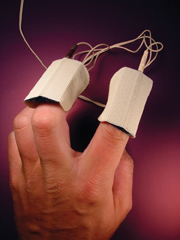
Would I Lie To You?
ASTM International Committee E52 on Forensic Psychophysiology Leads the Way on Standards for Polygraphy
For more than a decade, ASTM International Committee E52 on Forensic Psychophysiology has been developing a series of standards that cover all aspects of polygraphy, from research to ethics.
According to George Baranowksi, E52 member and owner, Mindsight Consultants, the committee held its organizational meeting in 1997 and was officially recognized by ASTM the following year.
"Surprisingly, even to me as an examiner, there were no real standards that were kept throughout the polygraphy profession," says Baranowski, who is president of the National Polygraph Association.
A U.S. district court decision in which a polygraph test was not allowed led to the formation of the committee. The court stated that there were no controlling standards to ensure proper protocol by which a defender's examination could be measured, despite the fact that individual polygraph organizations did maintain their own standards. Baranowski also notes that many polygraphers at that time did not belong to any professional organization.
In the wake of the court decision, a number of polygraphic examiners, including Richard Widup, who was with the U.S. Food and Drug Administration, and John Schwartz, with the U.S. Department of Justice, determined that ASTM would be an ideal venue for the development of polygraphy standards. Widup and Schwartz became the first chairman and vice chairman, respectively, of E52.
The first order of business for E52 was to create a series of subcommittees, including the following:
- E52.01 on Research. E52.01 developed the first E52 standard, E1954, Practice for Conduct of Research in Psychophysiological Detection of Deception (Polygraph), the first standard approved by E52. The standard concerns the qualifications required of polygraphic researchers and outlines how research should be done.
- E52.02 on Instrumentation, which focuses on standards for manufacturers of polygraph instruments.
- E52.03 on Quality Control. E2031, E52's quality control standard, which ensures that polygraph tests meet proper QC criteria, was created by this subcommittee.
- E52.04 on Examiner Education and Training. E52.04 has developed four standards for basic as well as advanced training for polygraphy.
- E52.05 on Psychophysiological Detection of Deception. Baranowski is currently chair of this subcommittee. E52.05 standards focus on the format that polygraphs take, including types of questions asked, locations for testing and other issues.
- E52.07 on Ethics in Administration of PDD Tests. E2065, Guide for Ethical Requirements for Psychophysiological Detection of Deception (PDD) Examiners, presents the ethical parameters of polygraph testing.
Baranowski says that, while different polygraphy organizations may continue to maintain their own standards, ASTM standards are now often cited by the organizations and are well known in the courts.
Currently chaired by Chris Fausett, Lafayette Instrument Co., E52 continues to develop standards, including a proposed new standard for interpreters.
According to Baranowski, developing standards through the ASTM process has been beneficial to the polygraphy profession. "This is something we need," says Baranowski. "Creating Committee E52 is one of the most valuable things that has occurred in regard to polygraph examinations. We have validity about what we're doing, and we're going where science takes us."
 SN Home
SN Home Archive
Archive Advertisers
Advertisers Masthead
Masthead RateCard
RateCard Subscribe
Subscribe Email Editor
Email Editor